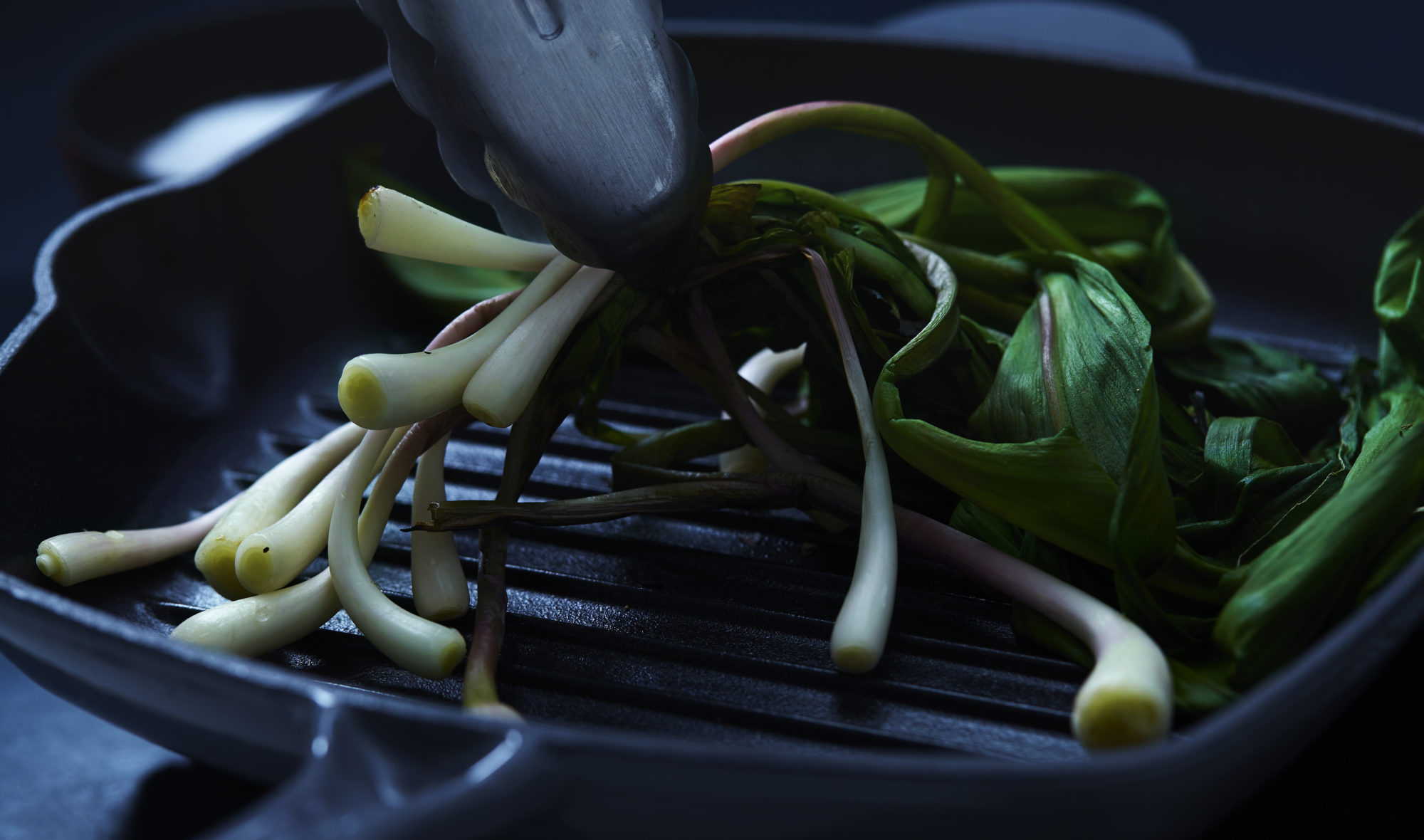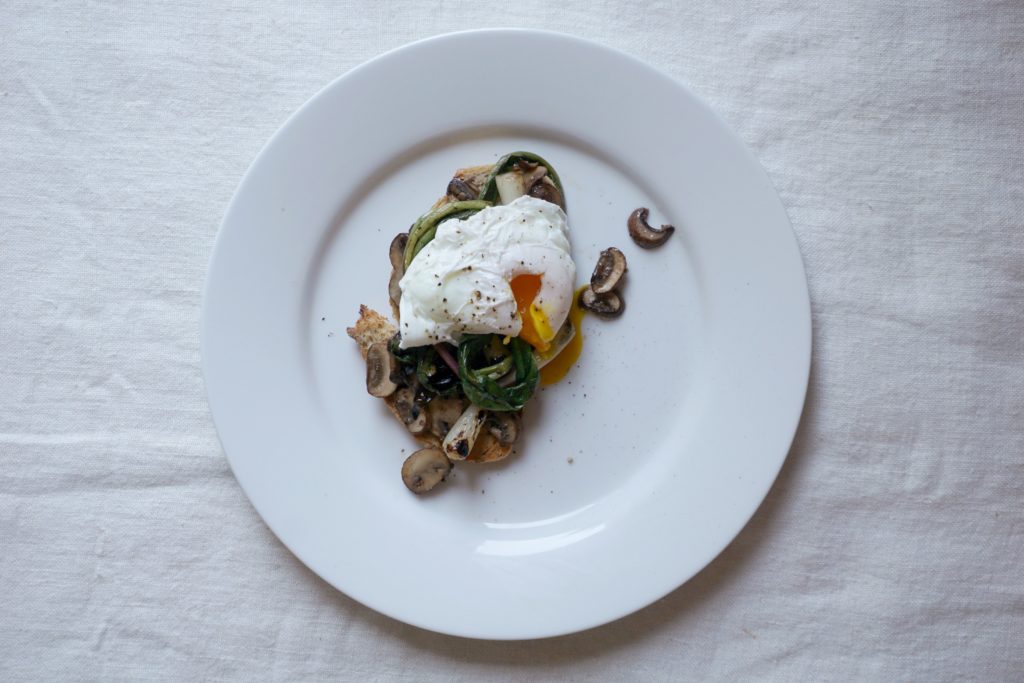
Sometimes called wild leek or spring onion, ramps make the hearts of chefs, foodies, and wild food foragers go aflutter. This is probably because ramps are only available for a limited time, and in limited quantities, creating an allure of exclusivity and delicacy. Ramps are a member of the Allium family, and grow wild, primarily in temperate deciduous forest environments. Ramps can be found as far north as Canada, as west as Minnesota, and as south as North Carolina. Ramps look a bit like a green onion, with small, solid white bulbs and broad, tapered green leaves. They have a pungent onion-y taste that is a cross between green onion and garlic, which mellows and sweetens when cooked. Ramps are low in calories, and a good source of beta-carotene, selenium, and chromium. The city of Chicago gets its name from the plant. “Chicago” comes from the word shikaakwa, the name local native tribes gave to the plants that grew in dense patches near Lake Michigan, which were later confirmed to be ramps.
For a limited time, you too can join in on ramp-mania, which occurs for a small window during late spring!
Sometimes called wild leek or spring onion, ramps make the hearts of chefs, foodies, and wild food foragers go aflutter.
This is probably because ramps are only available for a limited time, and in limited quantities. In some parts of Canada, the over-foraging of ramps has led to protective limits on how much a person can forage (50 bulbs per person, in case you’re curious). Therefore, an allure of exclusivity and delicacy has been created around this wild plant.
Ramps are a member of the onion, or Allium family, and grow primarily in temperate deciduous forest environments. Their broad green leaves poke out of the soil and the small, pale bulbs grow in moist, rich soil under the shade of maple, beech, poplar, and birch trees. Ramps can be found as far north as Canada, as west as Minnesota, and as south as North Carolina.
Interestingly, the city of Chicago gets its name from the plant. “Chicago” comes from the word shikaakwa, the name local native tribes gave to the plants that grew in dense patches near Lake Michigan, which were later confirmed to be ramps.
Ramps look a bit like a green onion, with some obvious distinguishing differences. Ramps have small, solid white bulbs; one end of the bulb ends in a collection of coarse little rootlets (which are sliced off and discarded before eating) and the other end continues into a purple or white shaft which splits off into two or three broad, tapered green leaves.
Ramps have a pungent onion-y taste that is a cross between green onion and garlic. When cooked, this flavor mellows out and sweetens, and the textures softens, much like a caramelized onion.
Half a cup of ramps (about 52g) has 16 calories, 4.0g of carbohydrates, and no appreciable amounts of protein, fats, sugar, or fiber. Ramps are a good source of vitamin A (in the form of beta-carotene), selenium, and chromium.
Ramps are typically only available for a short period of time – a window of about a month sometime in late spring. Because of their limited availability, you may only find them at farmers’ markets and specialty produce stores.
When selecting ramps, look for plants that have firm, solid bulbs and shafts with springy, bright green leaves. Pass over plants that look wilted, slimy, or broken.
Oh, and make sure you bring some cash when you buy ramps – they usually go for about $20 a pound.
To maximize freshness, store ramps by rolling them in a damp paper towel, and then place them in a plastic bag in the fridge. Stored this way, they will keep for about 4 days.
Ramps can also be blanched an then frozen for about 6 months.
The first thing to address with ramps is that they’re dirty – like leeks, they often hide bits of soil between their leaves, especially where the shaft splits into the leaves. So wash them well. Immerse them in a bowl of cold water, swish them around, and dump the water. Repeat until water runs clear, then give the plants a final rinse under cool running water.
Because of their strong pungency, ramps are usually eaten cooked, which mellows out their flavor.
Favored methods of preparation include sautéing or grilling.
Here’s how to sauté them:
Once ramps are washed, trim off the coarse butts and discard, then chop the ramps into pieces. Grab a large skillet and place it over medium-high heat, and add a good amount of butter, olive oil, or if you’re getting extra indulgent, bacon fat. Wait until the fat is sizzling, then drop the ramps into the skillet. Sauté for about 5-7 minutes, stirring occasionally to prevent burning. Ramps are done when the leaves are wilted and the bulbs are soft and translucent. Season with salt and pepper, and serve over toast, pasta, or with other cooked vegetables.

Ramps, or wild leeks, only have a small seasonal window in late spring / early summer. Catch them while you can, and make this savory, simple meal.
Prep Time: 20 minutes Cook Time: 15 minutes Yield: 4 servings
In a large bowl, add olive oil, vinegar, and mustard. Whisk to combine. To the same bowl, add ramps, and toss until ramps are coated with dressing.
To grill the ramps, place them on a medium-high grill and cook for about 1 minute. Using tongs, rotate the ramps and grill for another 1-2 minutes, until leaves are slightly charred and bulbs are soft.
Add butter to a skillet over medium-high heat, and allow to melt. Add sliced mushrooms, and saute until soft, about 5 minutes. While the mushrooms are cooking, toast the bread.
Once the mushrooms are cooked, portion them over the toasts. Portion grilled ramps on top of the mushrooms. Set these prepared toasts aside while you poach the eggs.
To poach the eggs*: Fill a small saucepan about 2/3 full with water, and bring to a rolling boil. Reduce to barely a simmer (small bubbles occasionally rise, but no rolling bubbles). Crack the egg into a small bowl, then tip the contents into the saucepan. Cook the egg for 4 minutes (this will yield an egg with a solid white and a runny yolk), then remove with a slotted spoon and place over the toast. Repeat for each remaining egg.
Once all the toasts are prepared, season with salt and pepper to taste, and a drizzle of olive oil if desired, then serve.
*Adding a couple of teaspoons of mild-tasting vinegar to the water will help the egg stay together as it cooks.
Precision Nutrition’s Encyclopedia of Food expands every single month as we highlight new foods and showcase beautiful food photography. If you’d like to stay up to date, simply click this link. From there, we’ll send you a FREE copy of our recipe book. We’ll also let you know when new and delicious foods are added to the site.
Sometimes called wild leek or spring onion, ramps make the hearts of chefs, foodies, and wild food foragers go aflutter. This is probably because ramps are only available for a limited time, and in limited quantities, creating an allure of exclusivity and delicacy. Ramps are a member of the Allium family, and grow wild, primarily in temperate deciduous forest environments. Ramps can be found as far north as Canada, as west as Minnesota, and as south as North Carolina. Ramps look a bit like a green onion, with small, solid white bulbs and broad, tapered green leaves. They have a pungent onion-y taste that is a cross between green onion and garlic, which mellows and sweetens when cooked. Ramps are low in calories, and a good source of beta-carotene, selenium, and chromium. The city of Chicago gets its name from the plant. “Chicago” comes from the word shikaakwa, the name local native tribes gave to the plants that grew in dense patches near Lake Michigan, which were later confirmed to be ramps.